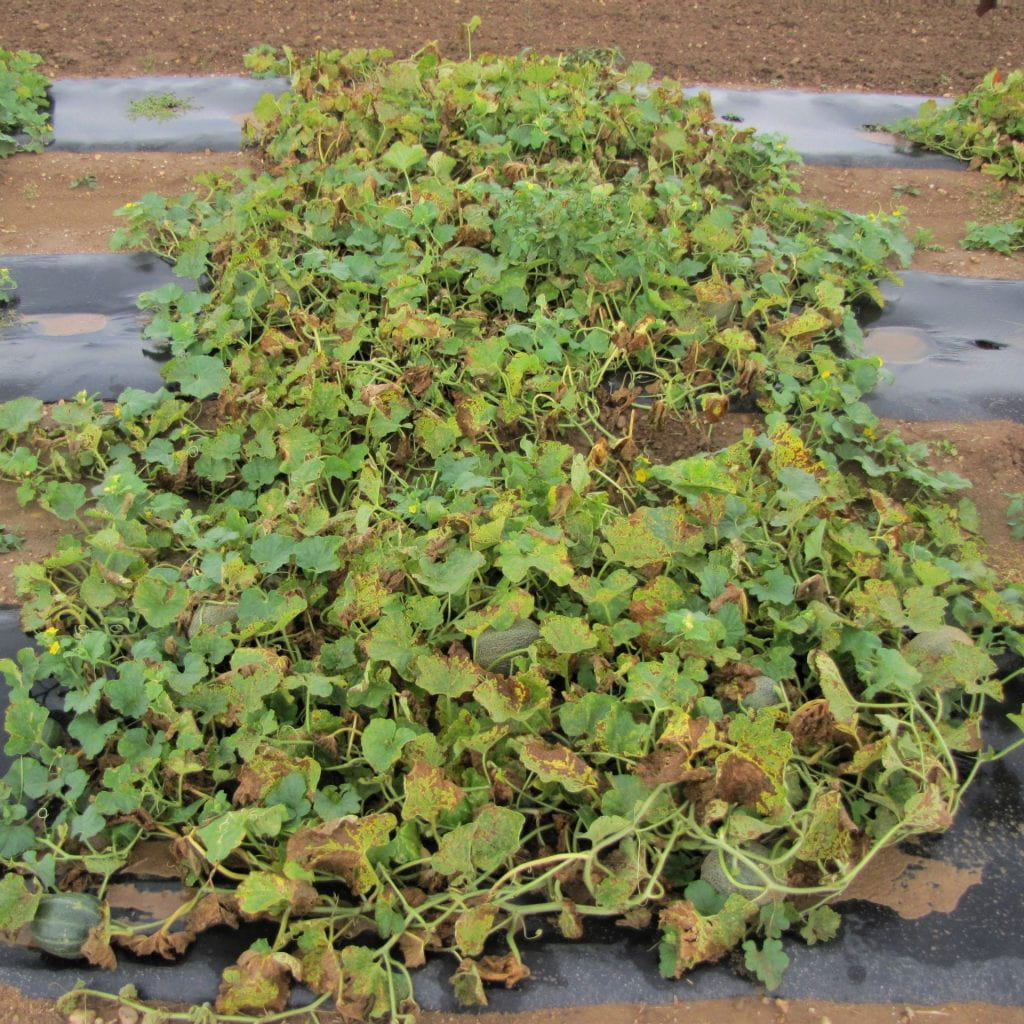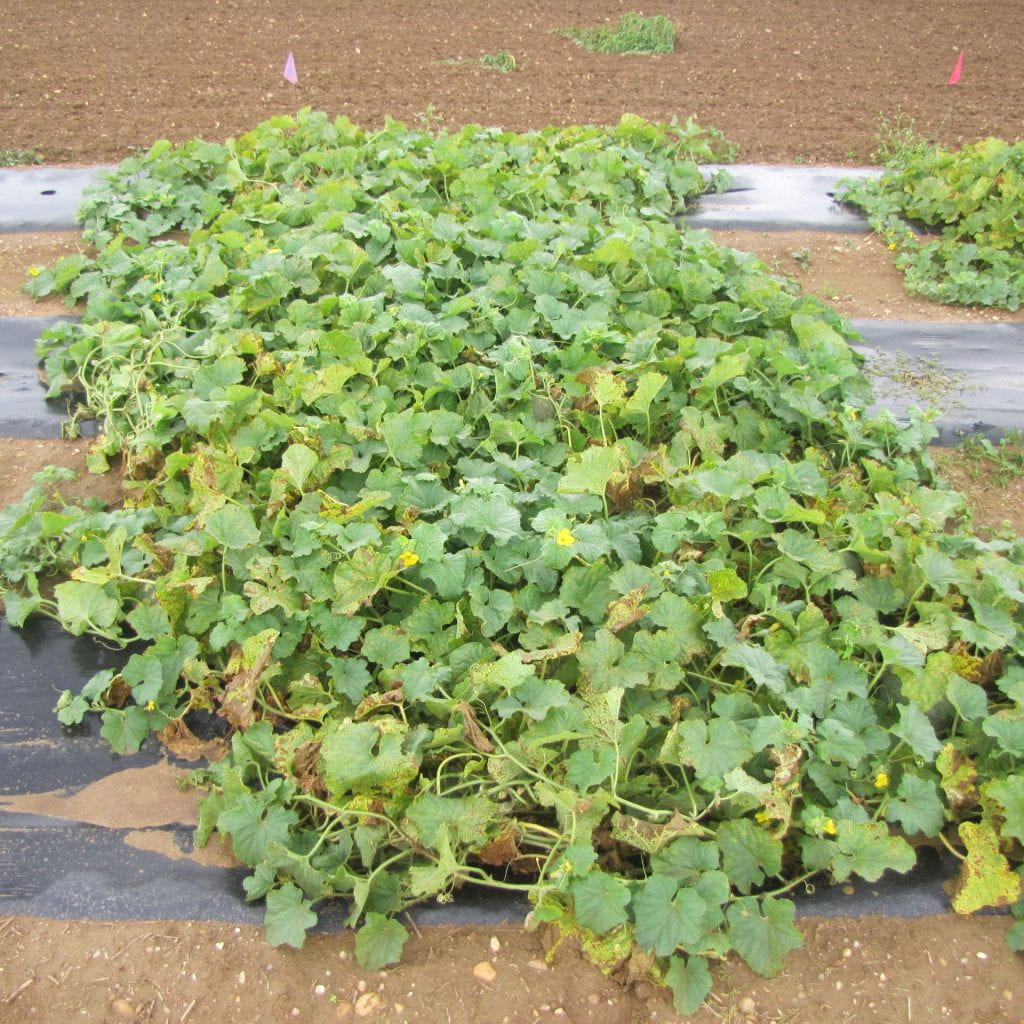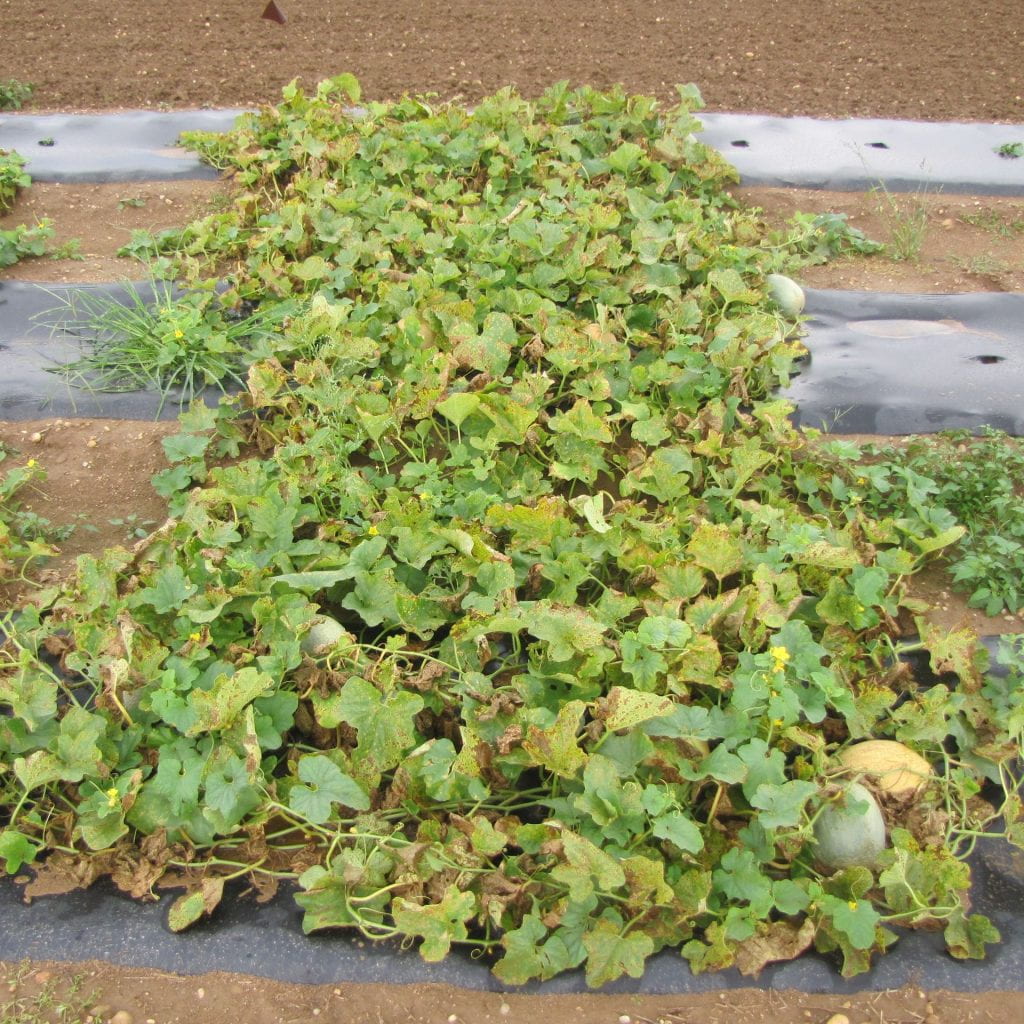This replicated experiment was conducted at LIHREC in 2021.
Topics on this page:
Margaret Tuttle McGrath
Plant Pathology and Plant-Microbe Biology Section, SIPS, Cornell University
Long Island Horticultural Research and Extension Center
3059 Sound Avenue, Riverhead, NY 11901; mtm3@cornell.edu
Downy mildew is a common disease affecting foliage of cantaloupe crops most years on Long Island. When it is not effectively managed, leaves die prematurely, and as a result fruit has poor flavor and lacks sweetness. Resistant varieties are a more economical management practice than routine fungicide applications, and a more practical management practice for a disease like downy mildew that is variable in when it occurs and that is most effectively managed on a susceptible variety when fungicide applications are started before or when symptoms start to develop. First observation of downy mildew in cantaloupe on Long Island has varied from 4 August to 20 September; twice in the past 14 years symptoms on cantaloupe were not observed in the LIHREC sentinel plots or commercial crops on Long Island. Applying fungicides when risk is predicted at the cucurbit downy mildew forecast website for where a crop is being grown helps target application timing and avoid some unnecessary applications, but there can be several high-risk forecasts before infection occurs. Downy mildew is recommended managed with an integrated program consisting of fungicides applied to a resistant variety starting when symptoms are first seen. Effective management is expected with fewer applications to a resistant variety by extending the application interval or shortening the treatment period. Additionally, an integrated approach will reduce selection pressure on the pathogen for fungicide resistance, which the pathogen has proven adept at achieving. Trifecta (which was developed at Cornell) and Edisto 47 are cantaloupe varieties with resistance to both downy mildew and powdery mildew. There are several other varieties resistant to powdery mildew. Growing a variety with resistance to both of these common diseases would facilitate being able to extend the fungicide application interval. The goal of this experiment conducted at LIHREC in 2021 was to assess degree of resistance to downy mildew of Edisto 47 and Trifecta by comparing them to two susceptible varieties. Another experiment was conducted to assess their resistance to powdery mildew. In each experiment targeted fungicides were applied to control the other disease. Yield and fruit quality were examined in the powdery mildew experiment. It is helpful for growers to know how well new varieties perform in terms of ability to suppress a disease, in order to select a fungicide program to achieve desired level of control, and also to know yield and fruit quality compared to standard varieties to determine whether a new variety is suitable for their operation.
Procedures
Mustard was grown in spring for biofumigation to manage the Phytophthora blight pathogen in the soil before planting the experiment. The field was moldboard plowed on 6 Apr and urea fertilizer (46-0-0) was applied at 80 lb/A N on 7 Apr. Mustard cover crop (Rojo Caliente) was seeded at 10 lb/A by drilling on 9 Apr. On 14 Jun the mustard was flail-chopped, immediately incorporated by disking, and followed by a cultipacker to seal the soil surface; the field could not be irrigated to initiate biofumigation as is recommended, but the soil was moist. Controlled-release fertilizer (N-P-K, 19-10-9) at 525 lb/A (101 lb/A N) was broadcast over the bed area and incorporated. Beds were formed with drip tape and covered with black plastic mulch. Seeds were sown in the greenhouse on 28 June. A waterwheel transplanter was used to make planting holes in the beds and apply starter fertilizer (9-18-9). Seedlings were placed outdoors to harden for a few days before transplanting by hand into the holes in the beds on 19 July. During the season, water was provided as needed via drip irrigation lines. Weeds were managed between the mulched beds by applying herbicide before transplanting and by hand weeding.
Powdery mildew was managed by applying Procure 8 fl oz/A on 20 August and 7 September, and Vivando 15 fl oz/A on 27 August.
Plots were three 8-ft rows spaced 68 in. apart with 9 plants per plot at 2-ft spacing. The plots were 4 ft apart within the row initially until plants began to vine, partly filling the area. Vines were moved as needed to maintain plot separation. A randomized complete block design with four replications was used.
Downy mildew severity was assessed on 4, 12, 20, 26 and 31 August; and 8 September by estimating incidence of symptomatic leaves in each plot and rating severity on nine representative affected leaves. Canopy severity was calculated by multiplying incidence by average severity. Area under disease progress curve (AUDPC) values were calculated from 4 August through 8 September. AUDPC is a summation measure of severity over time.
Results
Symptoms were first observed on 4 August, 16 days after transplanting. There were no significant differences in downy mildew incidence or severity between the two susceptible varieties. There were significant differences between the resistant and susceptible varieties starting with the third assessment on 20 August (see Table). There was significantly less defoliation in plots of the resistant varieties than plots of the susceptible varieties on 8 September and plots of Hales Best on 22 September (data not shown). There were no significant differences between the resistant varieties. Control of downy mildew achieved was 47% for Edisto 47 and 52% for Trifecta based on AUDPC values for canopy severity relative to average value for the susceptible varieties.
Conclusions
The cantaloupe varieties Trifecta and Edisto 47 exhibited good control of downy mildew and also powdery mildew.
Additional information: At the Cornell Vegetables website there are lists and tables of resistant vegetable varieties that include seed companies marketing them and whether organic seed is available, as well as variety resistance to disorders, and also additional information about downy mildew and its management.
Margaret Tuttle McGrath
Plant Pathology and Plant-Microbe Biology Section, SIPS, Cornell University
Long Island Horticultural Research and Extension Center
3059 Sound Avenue, Riverhead, NY 11901
mtm3@cornell.edu
Acknowledgments: This project was supported by the National Institute of Food and Agriculture, U.S. Department of Agriculture, Hatch under NYC-153409 and the Friends of Long Island Horticulture Grant Program.
Table
Ability to suppress downy mildew of resistant varieties of cantaloupe.
| Variety (reaction to downy mildew) | Downy mildew occurrence z | Defoliation (%) z | ||||||||||||||
| Incidence of symptomatic leaves (%) | Canopy severity (%) | |||||||||||||||
| 20-Aug | 8-Sep | AUDPC | 20-Aug | 8-Sep | AUDPC y | 8-Sep | ||||||||||
| Hales Best (susceptible) | 23.8 ab | 93 a | 1597 ab | 4.9 ab | 22 a | 431 a | 39 a | |||||||||
| Sugar Rush (susceptible) | 30 a | 94 a | 1652 a | 6.9 a | 23 a | 446 a | 28 a | |||||||||
| Edisto 47 (resistant) | 17.5 b | 78 b | 1309 c | 2.7 b | 9 b | 230 b | 6 b | |||||||||
| Trifecta (resistant) | 18 b | 85 ab | 1441 bc | 3 b | 11 b | 211 b | 1 b | |||||||||
| P-value (treatment) | 0.0243 | 0.0011 | 0.0003 | 0.0199 | 0.0003 | <0.0001 | <0.0001 | |||||||||
z Numbers in each column with a letter in common are not significantly different from each other (Tukey’s HSD, P=0.05).
y Values were square root transformed before analysis because raw data were not distributed normally. Table contains de-transformed values.
Images

Photographs of plots of each variety in the downy mildew experiment taken on 9 September.






